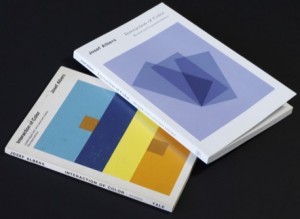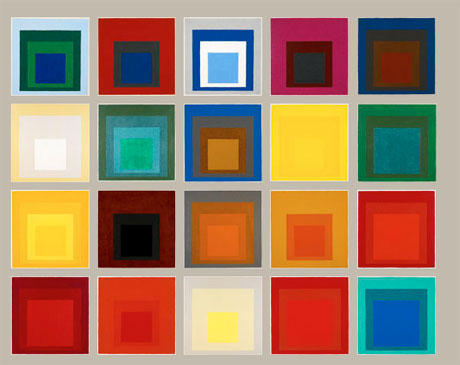My freshman year of college I took Color 101. We used Josef Albers’ classic Interaction of Color as the text. That experience opened my eyes to the difference between what a color is and what it appears to be. Almost forty years later I’m still learning new ways to look at color and loving every minute of it.
 It was standard practice to use ColorAid paper and rubber cement for the assignments. Teachers were tough. No white edges could show. No rubber cement could get on the surface of the paper. Lines had to be cut exactly square and exactly the right length.
It was standard practice to use ColorAid paper and rubber cement for the assignments. Teachers were tough. No white edges could show. No rubber cement could get on the surface of the paper. Lines had to be cut exactly square and exactly the right length.
A standard set of 220 ColorAid colors in the 6″x9″ size now costs $110 plus shipping. The full set of 314 colors is $158 plus shipping.
I can’t remember what I paid forty years ago but it was more than I could afford. That meant there was a lot of stress to not mess up.
I’m going to go out on a limb here and suggest that we try using polymer clay instead of ColorAid to mimic the various exercises in Albers’ book.
Color interactions are optical effects. The colors do not change but their appearance does. Over the next few Saturdays, as I am traveling to teach, I will post some samples of Albers’ exercises done in polymer clay. It will be fun way to see the various ways that colors shift as we go through chapter seven, “Playing Games with Color.”
 You may want to borrow or buy a copy of the student’s edition of Albers’ book. There are two versions of this paperback – be sure to get the latest revised and expanded edition with more color plates. (Its the one on top.) I have to warn you though, even with the extra plates, the text doesn’t have many samples of the exercises. That was always extremely frustrating for me since I am a visual learner!
You may want to borrow or buy a copy of the student’s edition of Albers’ book. There are two versions of this paperback – be sure to get the latest revised and expanded edition with more color plates. (Its the one on top.) I have to warn you though, even with the extra plates, the text doesn’t have many samples of the exercises. That was always extremely frustrating for me since I am a visual learner!
I recently purchased a reprint of the original book with 150 color plates. It was very expensive – certainly more than any college student could afford – but I am thrilled to finally add it to my library and share some of the plates with you!



March 22, 2023 at 1:27 pm
Maggie, thank you so much for your very educational post. I was VERY fortunate to learn that my local library has a circulating copy of the 2009 Albers reprint (which I just requested) and I couldn’t be more excited to work through the book in all its glory!
And by the way, your In the Garden & Oceana collections are absolutely stunning! Gorgeous!!
February 18, 2021 at 10:29 am
I just came across your blog today. I have a Color-Aid set from 1967. It cost $8.85 which was a fortune. I believe minimum wage was $1.15? I have used it sparingly over the years and am finally ready to use it up! There is an app of the Albers book available for $15, and it’s very good, but not as jaw dropping as turning the pages of the book.
October 10, 2011 at 10:36 am
Maggie: I still have most of my Color Aid deck…from college freshman Color 101. It has always seemed so pricey and dear to cut into = why not? And has moved with me many times. I am not sure one can still purchase rubber cement?
I agree with you, polymer clay is a much easier, accessible and affordable way to explore color and color interactions.
October 9, 2011 at 3:42 pm
Maggie, Albers’ Interactions of color is my bedside book. Nice recommendation.
Kisses
Ana